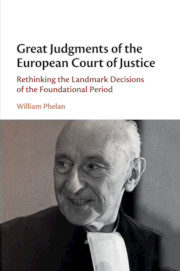29 results
Preamble and Selected Provisions of the Treaty of Rome
-
- Book:
- Great Judgments of the European Court of Justice
- Published online:
- 04 November 2020
- Print publication:
- 13 June 2019, pp xvi-xix
-
- Chapter
- Export citation

Great Judgments of the European Court of Justice
- Rethinking the Landmark Decisions of the Foundational Period
-
- Published online:
- 04 November 2020
- Print publication:
- 13 June 2019
Acknowledgements
-
- Book:
- Great Judgments of the European Court of Justice
- Published online:
- 04 November 2020
- Print publication:
- 13 June 2019, pp ix-xi
-
- Chapter
- Export citation
7 - Simmenthal, 1978
-
- Book:
- Great Judgments of the European Court of Justice
- Published online:
- 04 November 2020
- Print publication:
- 13 June 2019, pp 171-184
-
- Chapter
- Export citation
Tables
-
- Book:
- Great Judgments of the European Court of Justice
- Published online:
- 04 November 2020
- Print publication:
- 13 June 2019, pp viii-viii
-
- Chapter
- Export citation
Abbreviations
-
- Book:
- Great Judgments of the European Court of Justice
- Published online:
- 04 November 2020
- Print publication:
- 13 June 2019, pp xii-xii
-
- Chapter
- Export citation
Copyright page
-
- Book:
- Great Judgments of the European Court of Justice
- Published online:
- 04 November 2020
- Print publication:
- 13 June 2019, pp iv-iv
-
- Chapter
- Export citation
Introduction
-
- Book:
- Great Judgments of the European Court of Justice
- Published online:
- 04 November 2020
- Print publication:
- 13 June 2019, pp 1-12
-
- Chapter
- Export citation
9 - Internationale Handelsgesellschaft, 1970
-
- Book:
- Great Judgments of the European Court of Justice
- Published online:
- 04 November 2020
- Print publication:
- 13 June 2019, pp 197-220
-
- Chapter
- Export citation
3 - Costa v. ENEL, 1964
-
- Book:
- Great Judgments of the European Court of Justice
- Published online:
- 04 November 2020
- Print publication:
- 13 June 2019, pp 58-83
-
- Chapter
- Export citation
Epigraph
-
- Book:
- Great Judgments of the European Court of Justice
- Published online:
- 04 November 2020
- Print publication:
- 13 June 2019, pp v-vi
-
- Chapter
- Export citation
European Court of Justice Cases
-
- Book:
- Great Judgments of the European Court of Justice
- Published online:
- 04 November 2020
- Print publication:
- 13 June 2019, pp xiii-xv
-
- Chapter
- Export citation
Contents
-
- Book:
- Great Judgments of the European Court of Justice
- Published online:
- 04 November 2020
- Print publication:
- 13 June 2019, pp vii-vii
-
- Chapter
- Export citation
1 - Pork Products, 1961
-
- Book:
- Great Judgments of the European Court of Justice
- Published online:
- 04 November 2020
- Print publication:
- 13 June 2019, pp 13-30
-
- Chapter
- Export citation
Bibliography
-
- Book:
- Great Judgments of the European Court of Justice
- Published online:
- 04 November 2020
- Print publication:
- 13 June 2019, pp 242-256
-
- Chapter
- Export citation
4 - Dairy Products, 1964
-
- Book:
- Great Judgments of the European Court of Justice
- Published online:
- 04 November 2020
- Print publication:
- 13 June 2019, pp 84-122
-
- Chapter
- Export citation
10 - States and Individuals in the Great Judgments of the European Court of Justice, 1961–1979
-
- Book:
- Great Judgments of the European Court of Justice
- Published online:
- 04 November 2020
- Print publication:
- 13 June 2019, pp 221-241
-
- Chapter
- Export citation
5 - International Fruit, 1972
-
- Book:
- Great Judgments of the European Court of Justice
- Published online:
- 04 November 2020
- Print publication:
- 13 June 2019, pp 123-151
-
- Chapter
- Export citation
Index
-
- Book:
- Great Judgments of the European Court of Justice
- Published online:
- 04 November 2020
- Print publication:
- 13 June 2019, pp 257-258
-
- Chapter
- Export citation
8 - Sheep Meat, 1979
-
- Book:
- Great Judgments of the European Court of Justice
- Published online:
- 04 November 2020
- Print publication:
- 13 June 2019, pp 185-196
-
- Chapter
- Export citation



